The Science Behind "Metabolisms"
Everything You Need To Know About TDEE
It is a commonly held belief that people who tend to be thinner have “fast” metabolisms, whereas people who tend to be heavier have “slow” metabolisms. Often times, it seems as though some people can overeat and gain no weight, while others who eat the same amount gain significant amounts of weight. What people usually refer to when they say “metabolism” is a person’s basal metabolic rate (BMR), which represents the number of calories a person burns every day just by living. BMR can also be referred to as Resting Energy Expenditure (REE). [1] Contrary to popular belief, BMR does not usually have a large variance between individuals; rather it is Total Daily Energy Expenditure (TDEE) which tends to explain the bulk of the discrepancies in energy expenditure between any two individuals. [1,2]
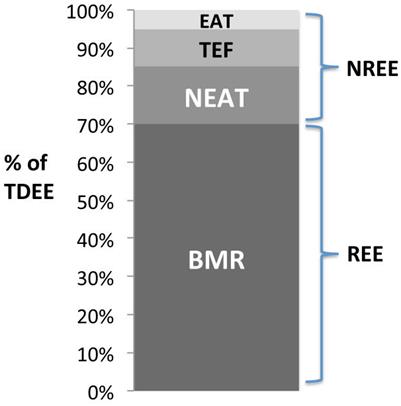
Total Daily Energy Expenditure (TDEE)
TDEE has multiple components, including BMR. BMR is generally the largest component, as it tends to range between ~60 –70% of most people’s TDEE.[3] Currently, evidence indicates that the main variable impacting BMR is the amount of Fat-Free Mass (FFM) that a person carries. [3-4] FFM accounts for all organs, tissue, and water within our bodies. Therefore, it makes sense that BMR is increased in people who add significant amounts of muscle mass to their frame. Muscle mass falls under the subcategory of “Fat-Free Mass” and it is an energetically demanding tissue at that. [5] It has been estimated that each additional pound of muscle mass increases BMR by about 6 calories per day on average. [6] Therefore, BMR can be increased by increasing muscle mass, although not by a substantial amount. Based on this information, we can conclude that a lack of muscle mass due to sedentary behaviors could very likely account for a large portion of the inter-individual differences in BMR. [4]
Additionally, regardless of muscle mass, the amount of FFM a person carries increases as they gain weight and decreases as they lose weight. [7] A reduction in FFM is the proposed mechanism for why people’s BMR will slow down when they lose weight. However, it seems that the decrease in BMR even with a 10% reduction in body weight is only 4 – 8%, meaning that BMR does not seem to significantly drop from moderate amounts of weight loss. [8] A 4% drop from 1600 calories would be a mere 64 calories, which is unlikely to have much of an effect on weight loss.
Non-Exercise Activity Thermogenesis (NEAT)
The second main component of TDEE is Non-Exercise Activity Thermogenesis (NEAT), which can make up 10 – 30% of TDEE. NEAT includes any and all activity that occurs outside of structured exercise: brushing your teeth, walking from room to room, fidgeting, maintaining your posture, etc. [10] NEAT is by far the most variable component of TDEE, and it usually explains most of its inter-individual differences, as well. [9] When someone goes into a period of severe caloric restriction, their TDEE can drop significantly through a reduction in low-intensity physical activities categorized as NEAT. [1,9,11] For example, if someone used to always rock in their chair while seated, they may subconsciously stop doing so when underfed. This adaptation is where individual responses can become important. The same principle applies when overeating; NEAT tends to increase in a caloric surplus. [12-13] At the same time, differences in how active someone is throughout their day because of their job can have enormous impacts on NEAT. [19] NEAT is the main reason that some people tend to burn so many more calories than other people do, creating the mirage of “fast” and “slow” metabolisms.
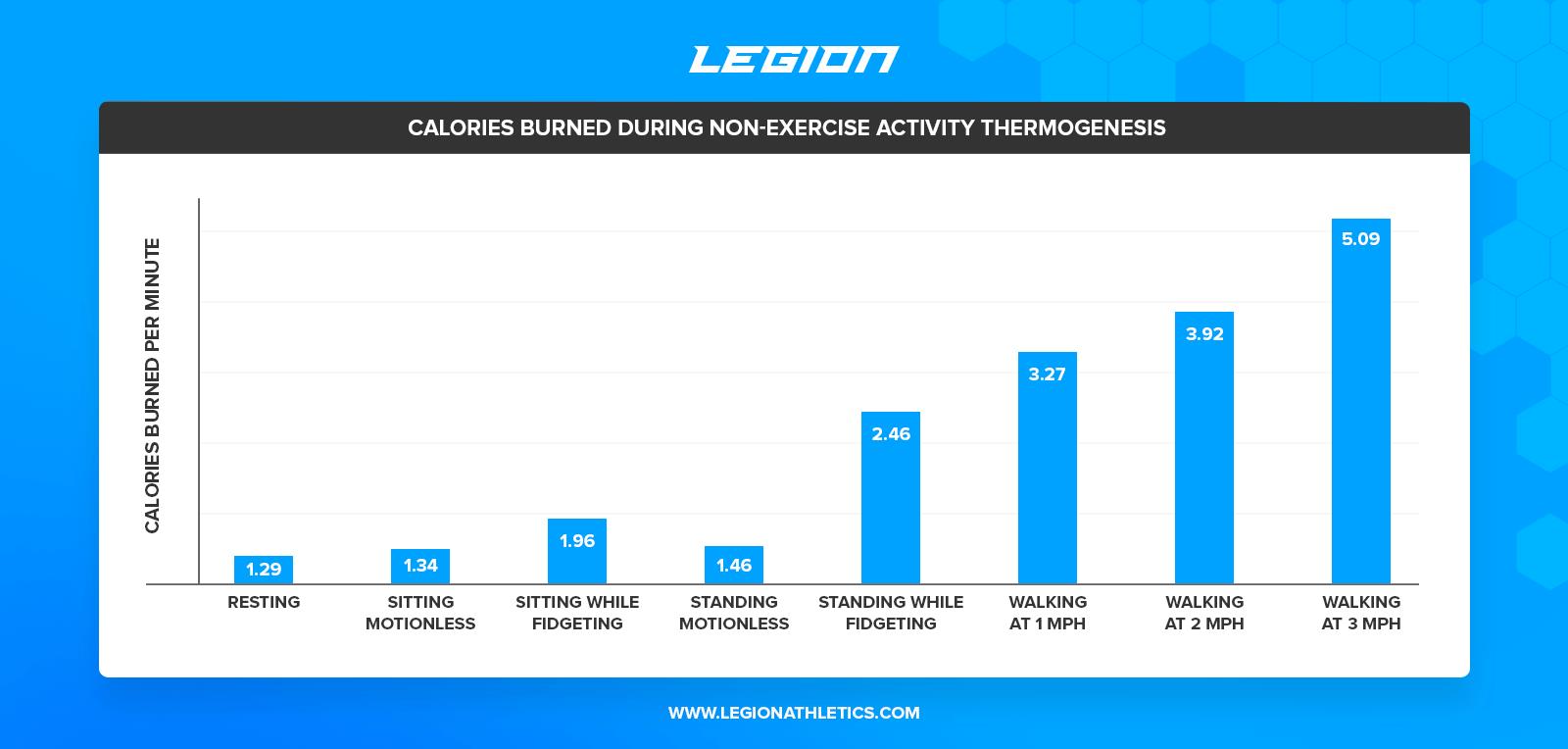
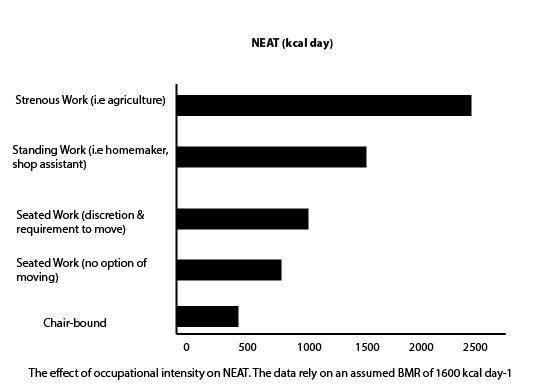
An important understanding is that different people will respond differently when eating in a deficit. Some people may see larger drops in NEAT than others. In the same way, some people will see greater increases in NEAT than others when eating in a surplus. If someone has a naturally larger increase in NEAT when they eat more, it will be more difficult for them to gain weight. Similarly, if another person has a naturally larger decrease in NEAT when undereating, it will be more difficult for them to lose weight. Of course, the change in NEAT is not likely to completely get rid of a caloric deficit or surplus, but it can certainly make changes in body-composition more difficult to achieve.
Because NEAT is the component of TDEE that is the most susceptible to these changes, strategies for increasing it can be beneficial towards weight loss or weight maintenance goals. One very simple way to increase NEAT is to set a daily step goal to keep steps mostly consistent. Another option is to set a weekly step goal and aim to average about the same amount of steps weekly. Tracking in such a way would keep the amount of energy expended through walking roughly the same day to day, even as you go into a caloric deficit. Therefore, this strategy ensures that the subconscious adaptations due to changes in eating habits will not significantly decrease TDEE. Inversely, in the case of the hard-gainer, decreasing NEAT in a similar manner is a viable option to make weight-gain less difficult. In this case, the main difference would be that the step goal can be set lower and the goal would be to keep activity below or at the threshold, not above it.
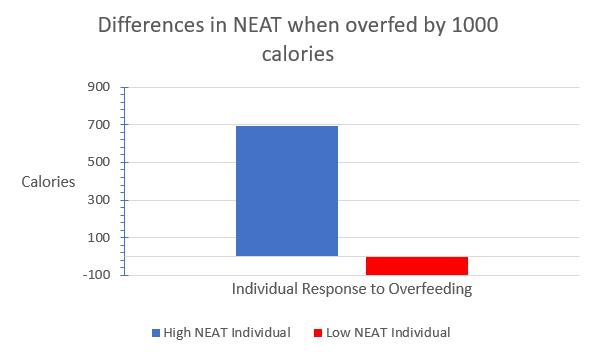
Thermic Effect Of Food (TEF)
The third component of TDEE is called the Thermic Effect of Food (TEF). TEF is essentially the amount of energy that it takes for your body to go through the process of digesting and storing the food that you eat throughout the course of the day. [1,14] This component makes up approximately 10 – 15% of TDEE. Because TEF depends on how much food the body is required to digest on a daily basis, it will be decreased when you eat less and increased when you eat more. Therefore, many people assume that increasing meal frequency will improve TEF. However, TEF actually remains the same regardless of whether two meals are consumed per day or even ten, assuming that the caloric content is equated throughout the day. [17] TEF depends primarily on the number of calories consumed and the macronutrient composition within the food, not the meal timing.
The food we eat is made up of three main macronutrients: fat, protein, and carbohydrates. Relative TEF differs between the three macronutrients, with the highest effect in protein and the lowest effect in fats. [15] On a per-gram basis, protein has a TEF of about 20 – 30%, carbohydrates have a TEF of about 5 – 10%, and fats have a TEF of only about 0 – 3%. [16] With this breakdown in mind, it should make sense that TEF, at least to a small degree, can be modified by the macronutrient breakdown of a person’s diet. Someone who switches from a high-fat, low-protein diet to a high-protein, low-fat diet will likely have increases in TEF. However, the extent to which changes in TEF actually affect weight management is minimal since even a change in TEF from 10% of TDEE to 15% of TDEE might only be an extra 100 – 200 or so calories. Of course, increased protein intake itself also has many benefits for weight management independent of TEF, including increased satiety and reductions in the loss of Lean Body Mass (LBM) seen during weight loss. The high TEF of protein can lead people who increase their protein intake to believe that they are benefitting from an increased TEF when the benefit is mostly derived from the increase in protein intake. It would likely benefit the majority of people who have healthy kidney and renal function to increase their protein intake, regardless of TEF, if the goal is weight management or weight loss.
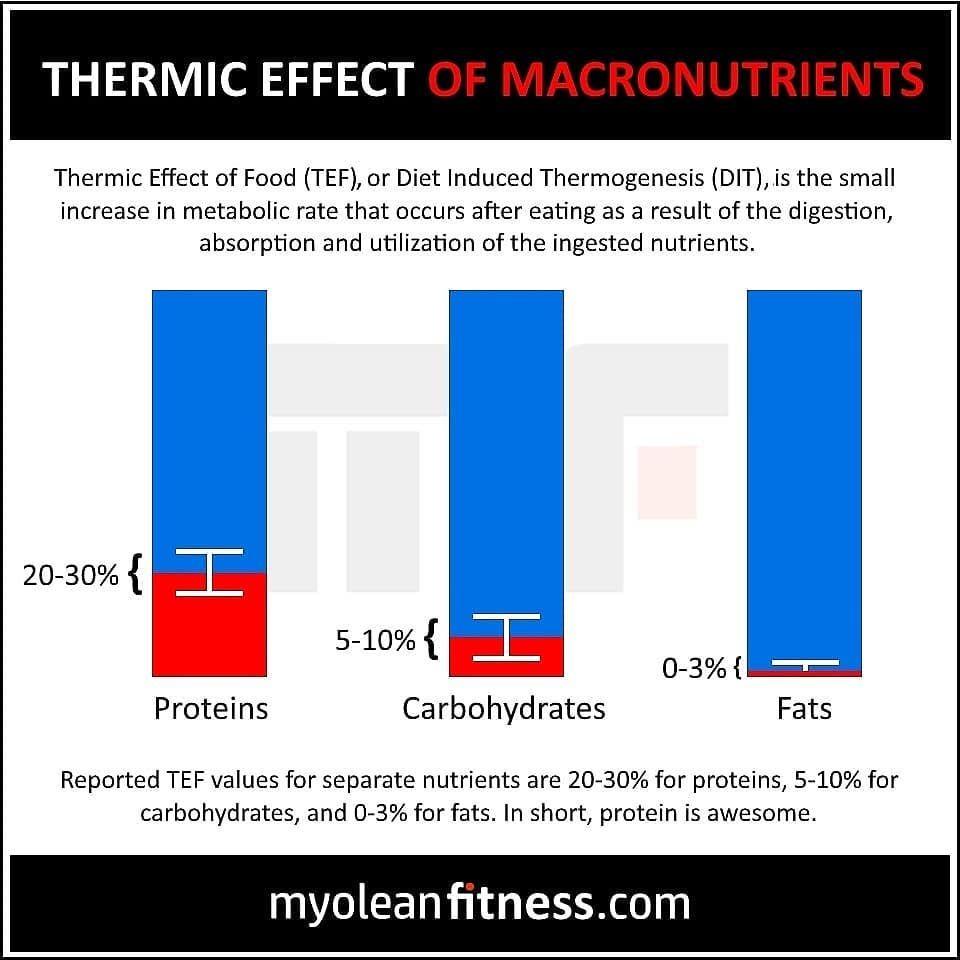
Exercise Activity Thermogenesis (EAT)
The final component of TDEE is called Exercise Activity Thermogenesis (EAT). EAT consists of any planned, structured physical activity done throughout the day, including weight training, cardio, yoga, etc. EAT is the smallest component of TDEE, only making up about 5 – 10% of it for most people. [1] For athletes, who spend multiple hours every day participating in a structured training regiment, EAT will be much larger. Similarly to NEAT, EAT seems to be subdued to an extent when in a state of caloric restriction. [1] Essentially, people who are losing weight may not be able to work out as intensely as people who are maintaining their weight or who are eating in a caloric surplus. However, unlike with NEAT, this adaptation may be more difficult to combat. If subconscious fatigue makes the exertion perceived from exercise seem higher, simply pushing through that fatigue would likely have negative repercussions. Due to these factors, both athletes and average trainees will often lower their overall training volume when dieting to avoid incurring excess fatigue. Regardless, TDEE will not generally be significantly affected from lowered EAT for the general population.
Conclusion
After a careful inspection of TDEE and its respective components, it should be clear that “metabolism” is extremely oversimplified by the majority of media outlets and is a much more nuanced and intricate topic than it is made to seem. Although genetic BMR can have a slight degree of variance, most differences in BMR can be attributed to differences in LBM. Increasing LBM is linked with many positive health outcomes aside from simply improving BMR, making it a beneficial intervention. Of course, there are certain exceptions, such as people with hypothyroidism, who have their BMR inhibited. However, only about 4.6% of Americans have hypothyroidism, and the majority of these cases are mild. [18] Additionally, if someone truly has hypothyroidism, a medical professional can give a diagnosis for it and administer a treatment which should mostly control the condition for the majority of people. [18]
Even if LBM is increased, the component of TDEE that is the most modifiable is still NEAT. Because NEAT tends to decrease in tandem with energy intake, tracking NEAT can be a valuable tool during weight-loss endeavors. Tracking can be done with a pedometer, Samsung or Apple Health, a phone app, a watch such as a FitBit or Apple Watch, etc. In this case, the most important factor is that the same device is used to track activity from day to day for the most consistency. Different devices can track steps drastically differently, sometimes even by thousands of steps. Tracking, however, is just a tool. Decreases in NEAT will not make weight loss “impossible”, even if you don’t track a single step. Tracking NEAT may help some people keep their TDEE higher while dieting, but it may cause other people to become obsessive and anxious about getting to a specific step count. Again, tracking NEAT is just a tool and not any kind of “magic trick”. If it causes someone more stress than it does benefit, there is no reason to continue to follow this specific tip. There are other tools that can work just as well, if not significantly better for weight loss, that revolve around limiting energy intake.
Overall, “metabolism” in its basic understanding does not have enormous variation between people. Differences in LBM and NEAT generally account for most of the differences in energy expenditure. Even though TEF and EAT are also important parts of TDEE, neither one is practically modifiable for the general population. Therefore, a “slow” or “fast” metabolism can instead be explained through the context of TDEE.
References
1. Trexler, E. T., Smith-Ryan, A. E., & Norton, L. E. (2014). Metabolic adaptation to weight loss: implications for the athlete. Journal of the International Society of Sports Nutrition, 11(1), 7. doi: 10.1186/1550-2783-11-7
2. Poehlman, E. T. (1989). A Review: Exercise and its Influence on Resting Energy Metabolism in Man. Medicine & Science in Sports & Exercise, 21(5). doi: 10.1249/00005768-198910000-00005
3. Alexandra M Johnstone, Sandra D Murison, Jackie S Duncan, Kellie A Rance, John R Speakman, Factors influencing variation in basal metabolic rate include fat-free mass, fat mass, age, and circulating thyroxine but not sex, circulating leptin, or triiodothyronine, The American Journal of Clinical Nutrition, Volume 82, Issue 5, November 2005, Pages 941–948, https://doi.org/10.1093/ajcn/82.5.941
4. Zurlo, F., Larson, K., Bogardus, C., & Ravussin, E. (1990). Skeletal muscle metabolism is a major determinant of resting energy expenditure. Journal of Clinical Investigation, 86(5), 1423–1427. doi: 10.1172/jci114857
5. David L. Williamson, John P. Kirwan, A Single Bout of Concentric Resistance Exercise Increases Basal Metabolic Rate 48 Hours After Exercise in Healthy 59–77-year-old Men, The Journals of Gerontology: Series A, Volume 52A, Issue 6, November 1997, Pages M352–M355, https://doi.org/10.1093/gerona/52A.6.M352
6. National Council. (n.d.). A Pound of Muscle Burns 30-50 Kcal/Day, Really…. Retrieved from https://www.ncsf.org/enew/articles/articles-poundofmuscle.aspx.
7. Willoughby, D., Hewlings, S., & Kalman, D. (2018). Body Composition Changes in Weight Loss: Strategies and Supplementation for Maintaining Lean Body Mass, a Brief Review. Nutrients, 10(12), 1876. doi: 10.3390/nu10121876
8. Rosenbaum, M., Hirsch, J., Gallagher, D. A., & Leibel, R. L. (2008). Long-term persistence of adaptive thermogenesis in subjects who have maintained a reduced body weight. The American Journal of Clinical Nutrition, 88(4), 906–912. doi: 10.1093/ajcn/88.4.906
9. Westerterp, K. R. (2016). Control of energy expenditure in humans. European Journal of Clinical Nutrition, 71(3), 340–344. doi: 10.1038/ejcn.2016.237
10. Levine, J. A. (1999). Role of Nonexercise Activity Thermogenesis in Resistance to Fat Gain in Humans. Science, 283(5399), 212–214. doi: 10.1126/science.283.5399.212
11. Chung, N., Park, M.-Y., Kim, J., Park, H.-Y., Hwang, H., Lee, C.-H., … Lim, K. (2018). Non-exercise activity thermogenesis (NEAT): a component of total daily energy expenditure. Journal of Exercise Nutrition & Biochemistry, 22(2), 23–30. doi: 10.20463/jenb.2018.0013
12. Apolzan, J. W., Bray, G. A., Smith, S. R., Jonge, L. D., Rood, J., Han, H., … Martin, C. K. (2014). Effects of weight gain induced by controlled overfeeding on physical activity. American Journal of Physiology-Endocrinology and Metabolism, 307(11). doi: 10.1152/ajpendo.00386.2014
13. Klein, S., & Goran, M. (1993). Energy metabolism in response to overfeeding in young adult men. Metabolism, 42(9), 1201–1205. doi: 10.1016/0026-0495(93)90281-r
14. Reed, G. W., & Hill, J. O. (1996). Measuring the thermic effect of food. The American Journal of Clinical Nutrition, 63(2), 164–169. doi: 10.1093/ajcn/63.2.164
15. Westerterp K. R. (2004). Diet induced thermogenesis. Nutrition & metabolism, 1(1), 5. doi:10.1186/1743-7075-1-5
16. Examine.com. (2019, September 11). Thermic Effect of Food - Frequently asked questions and scientific research summarized. Retrieved from https://examine.com/topics/thermic-effect-of-food/.
17. La Bounty, P. M., Campbell, B. I., Wilson, J., Galvan, E., Berardi, J., Kleiner, S. M., … Antonio, J. (2011). International Society of Sports Nutrition position stand: meal frequency. Journal of the International Society of Sports Nutrition, 8, 4. doi:10.1186/1550-2783-8-4
18. Hypothyroidism (Underactive Thyroid). (2016, August 1). Retrieved from https://www.niddk.nih.gov/health-information/endocrine-diseases/hypothyroidism.
19. Loeffelholz, C. von. (2018, April 9). The Role of Non-exercise Activity Thermogenesis in Human Obesity. Retrieved from https://www.ncbi.nlm.nih.gov/books/NBK279077/.
20. Myolean Fitness. (n.d.). "The Thermic Effect of Food (TEF)". Retrieved from https://www.instagram.com/p/BmbpD-OHgH2/.
21. Legge, A. (2019, September 12). Research Review: How Many "Hidden Calories" Are You Burning? Retrieved from https://legionathletics.com/non-exercise-activity-thermogenesis/.
22. Levine, J. A. (1999). Role of Nonexercise Activity Thermogenesis in Resistance to Fat Gain in Humans. Science, 283(5399), 212–214. doi: 10.1126/science.283.5399.212






